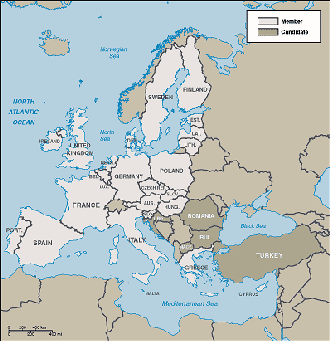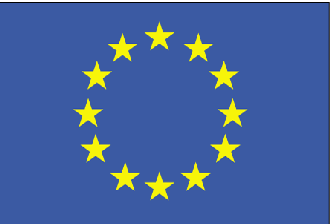
|
European Region
Location:
Europe is bounded to the north by the Arctic Ocean, to the west by the Atlantic
Ocean, to the south by the Mediterranean Sea, and, according to the traditional
geographic definition, to the southeast by the waterways adjoining the
Mediterranean to and including the Black Sea, and the Caucasus Mountains.
Europe's eastern frontier is vague, but has traditionally been given
as the divide of the Ural Mountains and the Caspian Sea to the southeast. The
Urals are considered by most to be a geographical and tectonic landmark
separating Asia from Europe.
Climate and Terrain:
Europe is the world's second-smallest continent in terms of area, covering
about 10,390,000 square kilometres (4,010,000 sq mi) or 2.0% of the Earth's
surface. The only smaller continent is Australasia.
The European Union, comprising 25 member states, is the largest political and
economic entity covering the European continent, with the Russian Federation
being the second.
People:
A number of countries in Europe have official religions, including
Liechtenstein, Malta, Monaco, Vatican City (Catholic); and Greece (Eastern
Orthodox), Denmark, Iceland and Norway (Lutheran). In Switzerland, some cantons
are officially Catholic, others Reformed Protestant. Some Swiss villages even
have their religion as well as the village name written on the signs at their
entrances. In 2003, the population of Europe was estimated to be 799,466,000,
or about one-eighth of the world's population. A century ago, Europe had nearly
a quarter of the world's population. The population of Europe has grown in the
past century, but in other areas of the world (in particular Africa and Asia)
the population has grown far more quickly - a population explosion.
Economy overview:
The European Union has the world's largest economy, probably slightly larger
than that of the United States of America with a 2005 GDP of 12,865,602 million
vs. 11,734,300 million (USD figures) (using nominal US Dollar GDP) according to
the International Monetary Fund. Using the purchasing power parity method
of computing GDP, the preferred comparative measure of economic output, the EU
and the US economies are virtually the same size. As the EU has 50% more
people than the US, but produces about the same economically, the average EU
citizen enjoys a per capita share of domestic product of about USD $28,100,
while in the US the per person GDP is over USD $40,000. One needs to consider,
however, that welfare states including Canada tend to have lower a GDP per
capita and that the EU contains countries of relatively low development in
eastern Europe. The Unemployment rate in the European Union in January 2006 was
8.5%, however the rate varies by member state, the lowest rates are in Denmark,
Ireland, the Netherlands and the United Kingdom at 4-5% to over 15% in Slovakia
and Poland, this compares with 4.1% in Japan and 5.1% in the United States
Statistics:
The European Union has large coal, oil, and natural gas reserves. There are six
oil producers in the European Union, although most oil production happens in
the North Sea oilfields. The United Kingdom by far is the largest producer,
however Denmark, Germany, Italy, and the Netherlands all produce oil. If it is
treated as a single unit, which is not conventional in the oil markets, the
European Union is the 8th largest producer of oil in the world, producing 3 244
000 (2001) barrels a day. However, it is also the world's 2nd largest consumer
of oil, consuming much more than it can produce, at 14 480 000 (2001) barrels a
day.
Return to Visiting Locations
|

